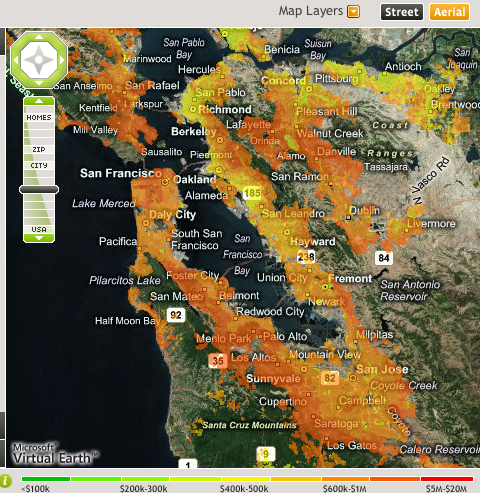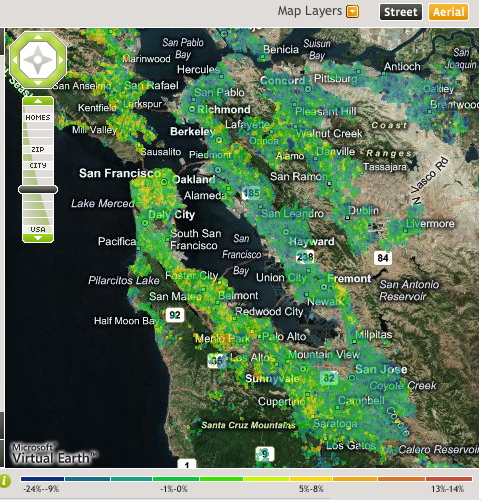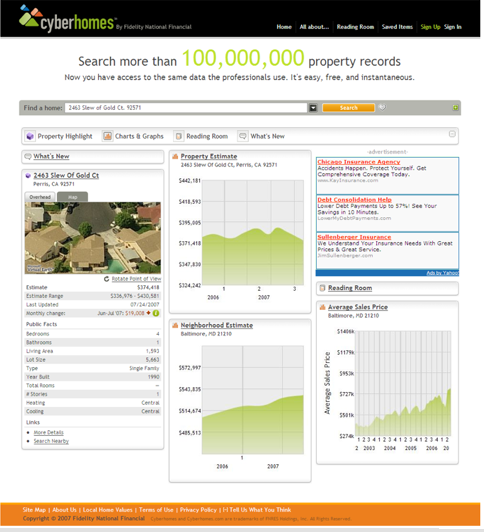 Even as the housing market goes south, real-estate Websites continue to soldier on. On Tuesday, after a year in beta, CyberHomes will launch officially and join a crowded field that includes Zillow, Trulia, Redfin, and Realtor.com. “Even as the housing market has slid,” argues CyberHomes CEO Marty Frame, “the audience online is at an all-time high and growing. I think the basic story here is that you can only access people through their concerns – and there are a lot of concerns out there.” As the former chief technology officer of Realtor.com, Frame is only too aware of how attitudes towards real estate have shifted over the past few years.
Even as the housing market goes south, real-estate Websites continue to soldier on. On Tuesday, after a year in beta, CyberHomes will launch officially and join a crowded field that includes Zillow, Trulia, Redfin, and Realtor.com. “Even as the housing market has slid,” argues CyberHomes CEO Marty Frame, “the audience online is at an all-time high and growing. I think the basic story here is that you can only access people through their concerns – and there are a lot of concerns out there.” As the former chief technology officer of Realtor.com, Frame is only too aware of how attitudes towards real estate have shifted over the past few years.
Like many other sites, CyberHomes allows homeowners and prospective purchasers to assess the value of particular properties, as well as general market conditions. For any property, you can see a list of comparable homes and how much they sold for. A new modular dashboard (based on Microsoft’s Silverlight) will personalize the homepage to each visitor’s preferences. There are also useful heat maps that show housing trends for a given city or region at a glance. Here is a heat map, for instance, of home prices in Silicon Valley (the redder the area, the more expensive the homes):
And here is a heat map for the same area showing thepercentage change in prices this year (blue indicates a slight decline, and green is flat):
But what exactly makes CyberHomes any different from the dozen other real-estate Websites out there? (After all, Trulia has heat maps). Frame says his data is better.
Yes, we have heard this before. (Zillow Zestimate, anyone?). But CyberHomes may actually have an advantage here in that it is owned by Fidelity National Financial, one of the biggest title-insurance companies in the country. As such, Fidleity National Financial has a direct view on every home transaction in the country. “The key differentiators on the data is that we are the primary aggregator of it.,” says Frame. Other than the Multiple Listing Service (MLS) that brokers use, any company that wants information on properties sold, home ownership, or mortgage issuance needs to license it from one of two sources: either Fidelity National Financial or First American (which is where Zillow gets its data, through an intermediary company called Dataquick). Since CyberHomes has a direct line into the Fidelity National Financial database, Frame argues that the data on his site is updated in a more timely fashion for the 100 million U.S. property records it covers. And it will begin to include actual MLS data as well, beginning in the first quarter of next year.
Anecdotally, CyberHomes was at least able to locate the building I live in, whereas Zillow could not. However, I am pretty sure CyberHome’s estimate of my apartment’s value is off the mark (by as much as 30 percent). This could be because CyberHomes does not have much information about my apartment other than its location and square footage. Of course, I can make adjustments with different sliders to better reflect local market conditions, as well as the condition of my apartment. This gets the price into the right ballpark. But if the price of my house is wrong, how can I trust any of the other estimates? So I guess I am still waiting for the perfect real-estate site to come along. Until then, the CyberHomes heat maps are pretty good real-estate porn.


